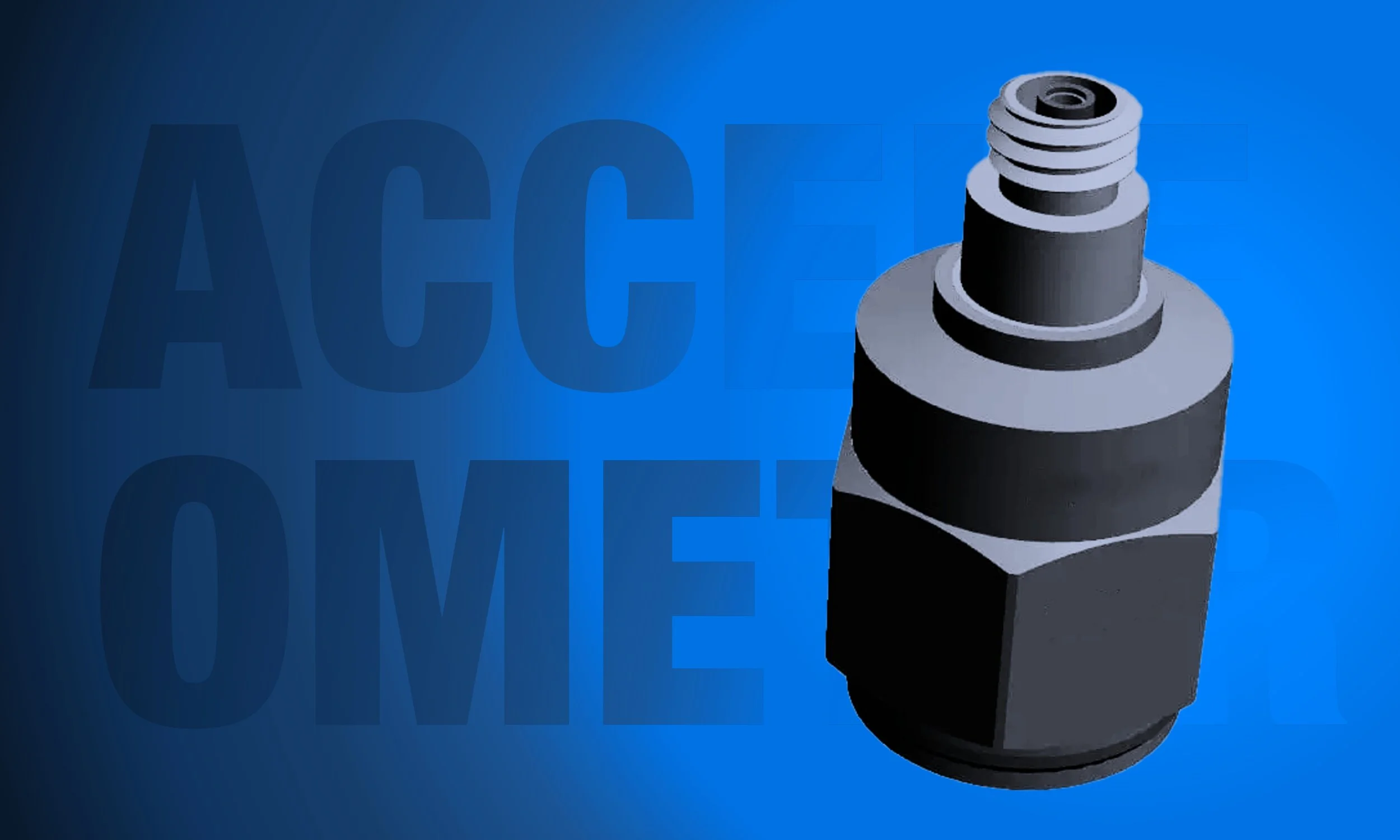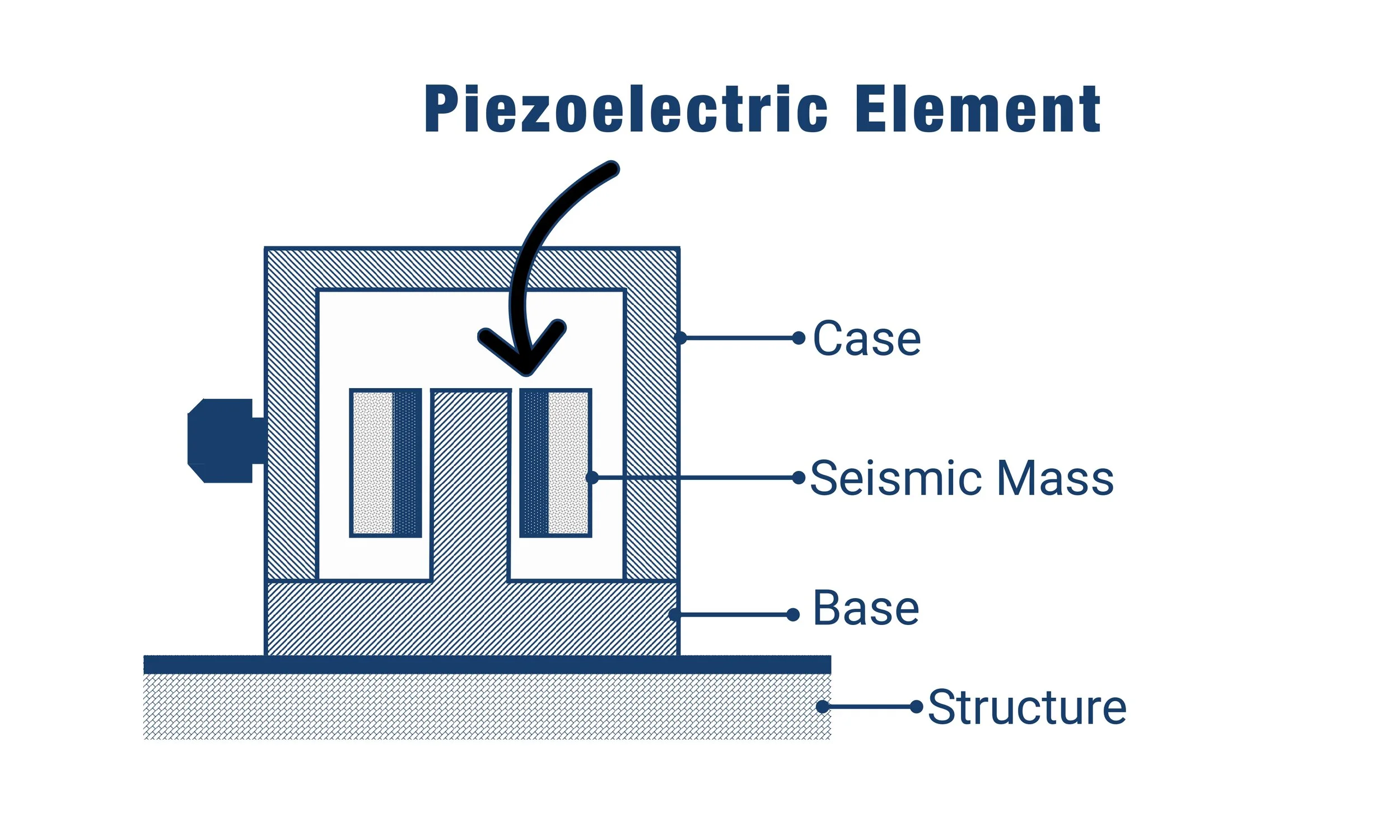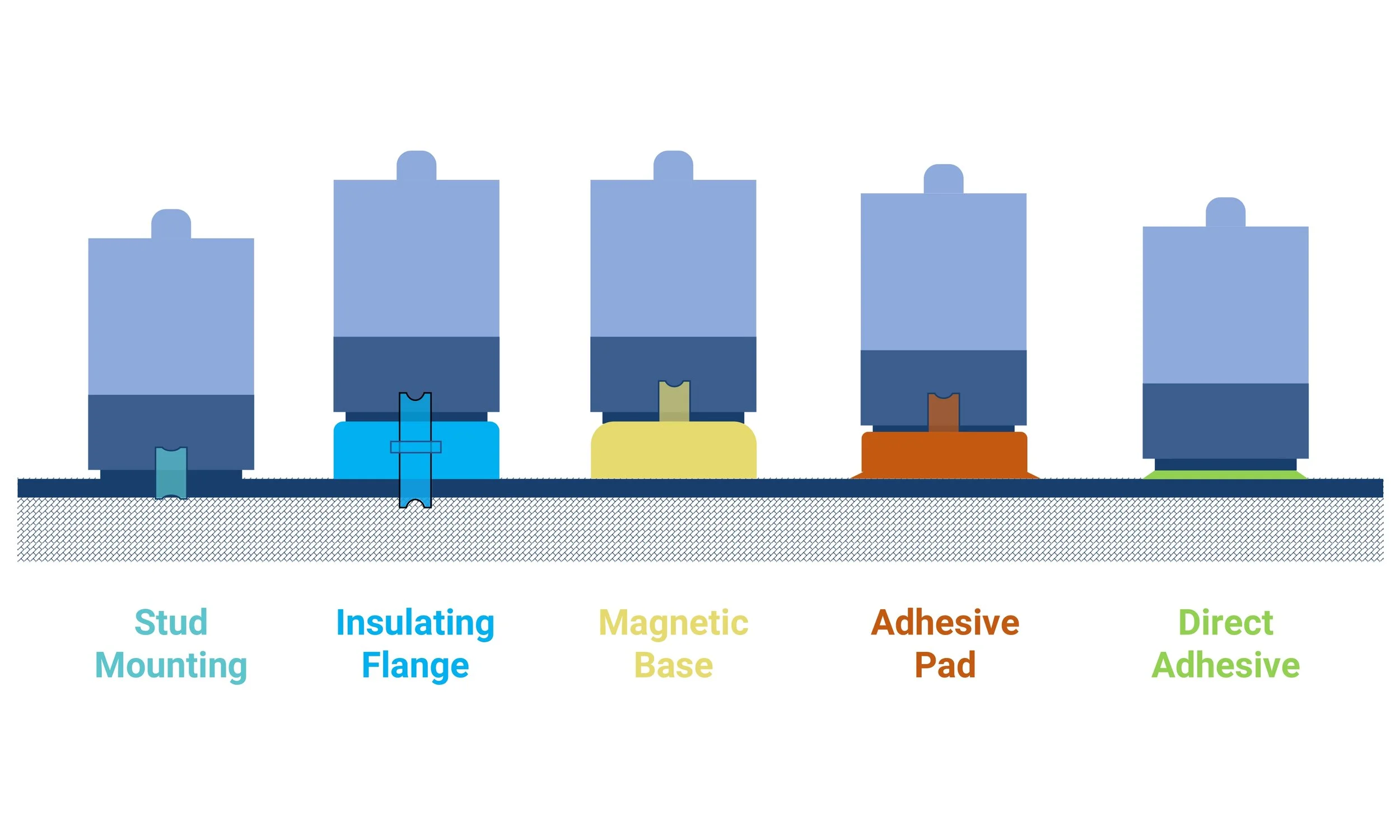One of the main components of a vibration testing system setup is the accelerometer. The accelerometer built-in amplifier type or charge type will feedback the signal back to the vibration controller or data acquisition.
What is an accelerometer?
An accelerometer is a device that measures the vibration, or acceleration of motion of a structure. They measure in meters per second squared (m/s2) or in G-forces (g). The force caused by vibration or an acceleration (change in motion) causes the mass to "squeeze" the piezoelectric material which produces an electrical charge that is proportional to the force exerted upon it. Since the charge is proportional to the force, and the mass is a constant, then the charge is also proportional to the acceleration.
Accelerometers are useful for sensing vibrations in systems or for orientation applications.
How does an accelerometer work?
Accelerometers are electromechanical devices that are designed to measure either static or dynamic acceleration.
Static acceleration is the constant force acting on a body, such as gravity or friction. These forces are predictable and uniform to a large extend. A good example is an acceleration due to gravity that is constant at 9.8m/s, and the gravitation force is almost the same at every point on earth.
Dynamic acceleration forces are non-uniform, and the best example is vibration or shock. A vehicle crash is a very good example of dynamic acceleration, as the acceleration change is sudden when compared to its previous state.
Basically, the accelerometers can detect acceleration and convert it into measurable quantities like electrical signals.
Typical accelerometers can measure acceleration on one, two, or three axes. Most smartphones usually make use of three-axis models, while cars simply use only a two-axis to determine the moment of impact.
The sensitivity of accelerometers is quite high as they’re intended to measure even very small shifts in acceleration. The more sensitive the accelerometer, the more easily it can measure acceleration.
Accelerometers Types
There are three different types of accelerometers that are designed to efficiently function in their intended environments. The three types are piezoelectric, piezoresistance, and capacitive.
A piezoelectric (PE) accelerometer utilizes the piezoelectric effect (piezoelectric materials produce electricity when put under physical stress) to sense a change in acceleration and are most commonly used in test and measurement applications. These devices offer a very wide measurement frequency range from a few Hz to 30 kHz and are available in a wide range of sensitivities, weights, sizes, and shapes. These accelerometers should be considered for both shock and vibration measurements. PE accelerometers are available with a charge or voltage (IEPE) output.
Piezoresistance (PR) accelerometers are much less sensitive than piezoelectric accelerometers, and they are better suited for shock measurements and transportation crash tests. A piezoresistance accelerometer increases its resistance in proportion to the amount of pressure applied to it. Because of the low sensitivity, they are being used less for vibration measurements. PR accelerometers generally have a wide bandwidth and the frequency response goes down to zero Hz often called “DC responding” or steady-state, so they can measure long duration transients.
The third type of accelerometer is the capacitive accelerometer. Capacitive accelerometers use changes in electrical capacitance to determine an object’s acceleration. When the sensor undergoes acceleration, the distance between its capacitor plates changes as the diaphragm of the sensor moves. These accelerometers have high sensitivities, narrow bandwidth, and outstanding temperature stability. These devices are highly desirable for measuring low-frequency vibration, motion, and steady-state acceleration.
Accelerometer Mounting
There are a few ways to mount an accelerometer to the device under test (DUT), and methods include everything from permanent mounting to temporary methods. Here are a few of the most common mounting methods.
The best mounting method uses a threaded stud or screw. Stud/screw mounting provides the best transmissibility at high frequencies since the accelerometer is virtually fused to the mounting surface. High-frequency response can be enhanced by the application of light oil between the accelerometer and the DUT. If this method of mounting is desired, accelerometers should be purchased that are designed for stud and/or screw mounting.
Adhesive mounting is often required, especially on small surfaces and PC boards. The preferred mounting adhesive is a cyanoacrylate because it can be easily removed (with the proper removal techniques). Many accelerometers are specifically designed for adhesive mounting and this fact will be noted on the data sheet. A stud-mount accelerometer may be mounted using an adhesive, but a cementing stud should be used to prevent the adhesive from damaging the accelerometer's threads.
Ground Isolation
Ground isolation becomes important when the test article's surface is conductive and at ground potential. A difference in ground voltage levels between the electronic instrumentation and the accelerometer may cause a ground loop resulting in erroneous data.
Accelerometers are available with ground isolation or with the ground connected to the accelerometer's case. Accelerometers with ground isolation usually have an isolated mounting base and, where applicable, an isolated mounting screw. In some cases, the entire accelerometer case is ground isolated.
Key Applications of Accelerometers
Majority of accelerometers are small, and they are often referred to as Micro-Electro-Mechanical Systems (MEMS) accelerometers.
Accelerometers find many applications in industries. You can find them in the most complex machines, in space stations as well in a myriad of hand-held electronic devices such as phones, tablets, and video game controllers.
Examples of some of the real-world applications of accelerometers:
Electronics - digital devices - accelerometers in smartphones, tablets and digital cameras are responsible for “flipping” the screen when the device is rotated.
Drones - accelerometers help drones to stabilize their orientation midflight.
Automotive - the invention of airbags have saved millions of lives over the years. Accelerometers are used to trigger the airbags as the sensor would send a signal when it experiences a sudden shock.
Rotating machinery - accelerometers used in rotating machines detect undulating vibrations.
Industrial Platforms - to measure platform stability or tilt.
Vibration Monitoring - machines that move generate vibrations, and these vibrations can be harmful to the machines if left to amplify without supervision. Accelerometers are useful in monitoring vibrations and are increasingly used in industrial plants, turbines, etc.
Accelerometers are also used by zoologists to track the movement of animals in the wild.
The motion sensors in accelerometers can even be used to detect earthquakes and may be used in medical devices such as bionic limbs and other artificial body parts.
How to choose an accelerometer?
Accelerometers are offered in a variety of technologies, shapes, sizes, ranges, etc., and choosing an accelerometer by looking into a manufacturer’s catalog or website can be intimidating to both the novice and often the more experienced users.
The first step in choosing an accelerometer is to determine the type of measurement to be made. As we have seen above, there are three widely used technologies used for acceleration measurements: piezoelectric (PE) accelerometer, piezoresistance (PR) accelerometers and capacitive accelerometer.
Type of measurements to be determined:
Vibration:
An object is said to vibrate when it executes an oscillatory motion about a position of equilibrium. Vibration is found in transportation and aerospace environments or as simulated by a vibration shaker system.
Shock:
A sudden transient excitation of a structure generally excites the structure’s resonances.
Motion:
Is a slow-moving event such as the movement of a robotic arm or an automotive suspension measurement.
Seismic:
This is more of a motion or a low-frequency vibration. This measurement usually requires a specialized low noise–high-resolution accelerometer.
The frequency response is another important parameter when choosing an accelerometer. This parameter is usually specified within ±5% of the reference frequency (usually 100 Hz). Many devices will have the specifications extended to ±1 dB and in some cases ±3 dB. Most data sheets will have a typical frequency response curve to assist the user. The frequency range will usually be determined by the test specifications or as determined by the user.
Another consideration is the number of axes to be measured. As we have seen above, accelerometers are available in single and triaxial versions. Another approach to making a three-axis measurement is to mount three accelerometers on a triaxial mounting block. Both methods allow for the measurement of three orthogonal axes simultaneously.
Below are a few questions to ask yourself that will help you in choosing the correct accelerometer for your application:
What is the vibration amplitude to be monitored?
What is the frequency range to be monitored?
What is the temperature range of the installation?
What is the size and shape of the sample to be monitored?
Are there electromagnetic fields?
Is there a high level of electrical noise in the area?
Is the surface where the accelerometer is to be mounted grounded?
Is the environment corrosive?
Does the area require intrinsically safe or explosion-proof instruments?
Is the area a wet or a wash-down area?
How to choose the right accelerometer for Vibration Test?
Vibration testing is about introducing a specified level of energy into a DUT at a single frequency or over a range of frequencies. Normally we control and measure that energy with one or more accelerometers attached to the vibration fixture or the DUT or both. Understanding the capabilities of these accelerometers is important to ensure that vibration energy is introduced into the DUT within the limits specified in your test procedure.
A few of the more important accelerometer characteristics that you need to consider when selecting an accelerometer for a vibration test are sensitivity, frequency response, temperature and mass loading. An accelerometer’s sensitivity is the ratio of its output (in mV or picocoulombs) to its input in g’s. If you’re performing a test at a low level (like 0.25g rms) it’s necessary to select an accelerometer that has a high sensitivity otherwise the controller will not receive a signal higher than the background electrical noise and will be unable to control the shaker.
Accelerometers are designed to measure acceleration accurately over a range of frequencies. Some are optimized for lower frequencies, even down to DC levels, others are good at measuring at very high frequencies but can’t accurately measure below 2 Hz. Because of this, it’s necessary to match the frequency response of the accelerometer to the frequency range of your test profile. The manufacturers’ specification for the accelerometer will define the acceptable frequency range for the accelerometer.
The temperature which an accelerometer is exposed to will affect its sensitivity and can significantly change the acceleration values that you’re measuring. Again, the manufacturers’ specification for the accelerometer should be consulted to ensure that your accelerometer will measure accurately at the temperature under which you’re testing.
The mass of the accelerometer that you attach to your DUT, will change the mass of the DUT itself. When you change the mass of your DUT, you also change its frequency response, so that the resonance that you measure with a 5 gram accelerometer will not be the same frequency if you’ve mounted a lightweight 0.5 gram accelerometer to your circuit board.
As a rule of thumb, the weight of the accelerometer should be no greater than 10% of the weight of the DUT.
Piezoelectric accelerometers are the first choice for most vibration measurements since they have a wide frequency response, good sensitivity, and resolution, and are easy to install. There are two subdivisions of piezoelectric accelerometers which include the basic charge-mode accelerometer and the voltage mode Internal Electronic Piezoelectric (IEPE) types.
Choose your accelerometers carefully for the condition you want to measure and the environment they will experience and you'll always get reliable and accurate acceleration data.
If you have problems in choosing the right accelerometer for your application, ETS will be happy to assist you.
References:
Tony Araujo - Director and Chair - Conformity Assessment Division at Canadian Council of Independent Laboratories
Bruce Lent - Senior Applications Engineer





